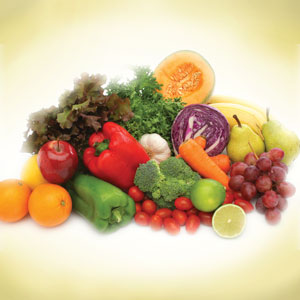Adding Color to Your Plate

Q. I am a vegetarian, but I am not sure if my diet is healthy! There is so much conflicting information about eating right. Can you shed some light on following a diet that does not require a PhD in nutrition?
So the doctor said, “No sugars, limit the starches, and increase the fiber and protein.” That is and was always the best choice for healthy eating—but when we visited a vegetarian restaurant the other day, they had deep fried pooris, deep fried papad, potato curry, yogurt-rice, idli, dhosas, upadam, three types of rice and dal with tindola, gulab jamun, and rice pudding.
No, that will not provide the daily protein nor the fiber—this diet is conducive to metabolic syndrome and diabetes mellitus. There are 30 million confirmed diabetes patients in this country and perhaps another 10 million who don’t know they have it or are prediabetic. India boasts 200 million diabetes patients, and the numbers are on the rise.
The American Diabetes Association and the American Heart Association talk about increasing fiber, fruits, and vegetables in the diet and eating a rainbow of colors, five colors a day. Likewise, “Adding a splash of colorful seasonal foods to your plate makes for more than just a festive meal. A rainbow of foods creates a palette of nutrients, each with a different bundle of potential benefits for a healthful eating plan,” said Karen Ansel of the American Dietetic Association. Natural chemicals in the vegetables and fruits are called phytochemicals (phyto is Greek for “plant”). These provide essential minerals, antioxidants, immunity strengthening chemicals, and essential vitamins.
Darker and stronger colors show greater potency; for example, a red tomato has stronger ingredients than a pale green one. Similarly, a red grapefruit has more antioxidants than the white kind.
Red pigments in vegetables and fruits indicate lycopenes and anthocyanins, which can fight prostate cancer. Red peppers and red tomatoes are rich in beta carotene, an antioxidant. Antioxidants protect against heart disease; prevent cell damage; help control serum sugars; improve memory, vision, and immunity; and fight against cancers of the gall bladder and the gastrointestinal tract. Foods with anthocyanins include red cabbage, red potatoes, radishes, red grapes, and strawberries. Other red fruits are cherries, cranberries, pomegranate, red/pink grapefruit, red grapes, and watermelon, and veggies include beets, red onions, and rhubarb. For those who love chocolate covered strawberries, eat them—they’re better than a vitamin capsule!
Red wine has resveratrol that is heart protective, helping to reduce blood pressure and LDL cholesterol. The author in no way encourages taking up alcohol drinking; however, if one drinks, then consider red wine and no more than a glass a day to keep its medicinal value.
Orange and deep yellow foods can promote healthy vision and immunity, and reduce the risk of some cancers. Citrus fruits, for example, are loaded with vitamin A, which is said to have cancer protective benefits and helps against depression and blood pressure elevation. Vegetables include carrots, yellow pepper, yellow corn, and sweet potatoes. For fruits, try apricot, cantaloupe, grapefruit, mango, papaya, peach, and pineapple.
Green produce has antioxidant potential and may help promote healthy vision and reduce cancer risks. Spinach and parsley are high in vitamins A and K. Green fruits include avocado, apples, grapes, honeydew, kiwi, and lime.
Cruciferous vegetables like broccoli, cauliflower, and cabbage should not be microwaved since the heat kills the nutrients. Similarly, boiling at very high temperatures allows nutrients to escape. If you steam vegetables, don’t let the steam escape, and consume the nutrient-rich cooking water. Try slow cooking veggies like broccoli, cabbage, and kale (as well as others like carrots and tomatoes) to keep the nutrients in.
Purple and blue are possible! These foods may have antioxidant and anti-aging benefits and may help with memory, urinary tract health, and reduced cancer risks: Fruits: blackberries, blueberries, plums, raisins; Vegetables: eggplant, purple cabbage, purple-fleshed potato.
Some white, tan, and brown foods contain nutrients that may promote heart health and reduce cancer risks. Good examples are fruits: banana, brown pear, dates, and white peaches; and veggies: cauliflower, mushrooms, onions, parsnips, turnips, white-fleshed potato, and white corn.
So instead of a pale plate of oily chicken and starchy rice, try a colorful plate with salsa, sweet potato, even an asparagus and spinach salad with orange slices! Keep your plates busy with color to make the food palatable and bursting with food value.
[Gulshan Harjee, M.D., is a board certified internist in private practice with an emphasis on prevention. Please email your health and medical questions for consideration in this column to: gharjee@comcast.net. The material in this column is of a general nature, and must not be construed as specific medical advice. This column rotates monthly along with the Fitness Lifestyle column by Aarti Patel.]
Enjoyed reading Khabar magazine? Subscribe to Khabar and get a full digital copy of this Indian-American community magazine.
blog comments powered by Disqus










